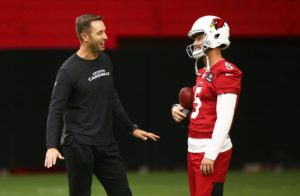This is an obvious situation to go for it, particularly when you are a 13-point underdog. Only contortionists can concoct 4th-and-1 situations where going for it is a bad idea, and nobody can sustain that argument from the opponent’s 4-yard line in the first quarter. And yet, Cardinals head coach Kliff Kingsbury sent out Zane Gonzalez to kick a short field goal, cutting the lead to 7-3.
After the next Baltimore drive resulted in a field goal, Arizona again drove down the field. The Cardinals reached 3rd-and-goal from the 3-yard line, when Murray threw an incomplete pass. That set up 4th-and-goal from the 3, trailing 10-3 midway through the 2nd quarter. This was another obvious go-for-it situation, but once again, Kingsbury sent Gonzalez out to get three points. Over the last 10 years, NFL offenses have scored touchdowns on about 41% of 3rd (or 4th) and goal plays from the 3-yard line. And as we’ll see in a minute, a 41% success rate is far above the necessary rate to make going for it the correct decision.
On Arizona’s first drive of the second half, trailing 17-6, Arizona once again drove inside Baltimore’s 10-yard line. On 2nd-and-goal from the 5, Murray threw to Larry Fitzgerald. Incomplete. On 3rd-and-goal from the 5, Murray again failed to connect with Fitzgerald. Facing 4th-and-goal from the 5, the Cardinals again sent out Gonzalez for a third chip shot. The Ravens defense was then called for a delay of game, moving Arizona up to the 2-yard line. From there, Kingsbury — trailing by 11 in the 2nd half — kept Gonzalez on the field! In perhaps the most indefensible move of the day, Kingsbury chose to kick a field goal. Over the last 5 years, teams have converted half of these 3rd (or 4th) and goal plays from the 2 into touchdowns.
A record three field goal attempts from inside the opponent’s 4-yard line, all while trailing, all while playing in a game as a heavy underdog. Coaches consistently cite “situational reasons” trumping what the efficient models advise for why they choose to make conservative decisions, but rarely think about what should cause them to be aggressive. Even in a neutral game, your average team should go for it on all three of these plays. It has long been known that you should go for it in these situations, which are all pretty easy calls. But in these situations, the conservative choice was doubly bad given that Arizona was trailing and a heavy underdog.
Last year, I wrote about why a touchdown isn’t worth 2.33 times as much as a field goal: that is, the value isn’t the 7-to-3 ratio you might think it is. Following either a touchdown or a field goal, the scoring team kicks off and the other team gains possession. And remember that offenses are now better than ever, and the new touchback rule means most possessions begin at the 25-yard line following a kickoff. This means having possession is more valuable than it used to be.
Last season, the average starting field position after a kickoff was the 26-yard line. And on those drives, teams averaged 2.0 points per drive.
Think about what that means: after a kickoff, you can expect the average team to score two points, and the Ravens at home are at least that good. Based on the data from last year, we expect the average team to score on about 35% of all drives, punt on 42% of drives, and have a turnover on about 12% of drives. The remaining drives will be missed field goals, turnover on downs, end of half drives, or other random events. On average, possession following a kickoff at the 26-yard line is worth about 1.2 expected points (and if anything, my suspicion is that this number will go up as models incorporate more recent data).
This means after kicking a field goal, the Cardinals should have expected Baltimore to take back 1.2 of the 3 points they just put on the board, netting Arizona 1.8 points. After a touchdown, you would expect the Ravens to take back 1.2 of the 7 points you put on the scoreboard, so you net 5.8 points. At a minimum, this makes a touchdown well more than 3 times as valuable as a field goal… and even more so in a game where you are a heavy underdog. And don’t forget, in the bad case scenario, a missed 4th down attempt pins the opponent back in a situation where you are still the more likely team to score next.
As it turns out, after the 3 field goals in question, the Ravens responded with 60, 85, and 70 yard drives for 3, 7, and 3 points. Getting those 3 points on the board wasn’t worth much, because it just resulted in Baltimore getting its offense back on the field. Arizona wound up being down 4 points with the result of their three scoring drives and the Ravens immediate responses. Kingsbury made the same wrong decision three times today, and it was the sort of wrong decision that was even more misguided when you considered the circumstances.

